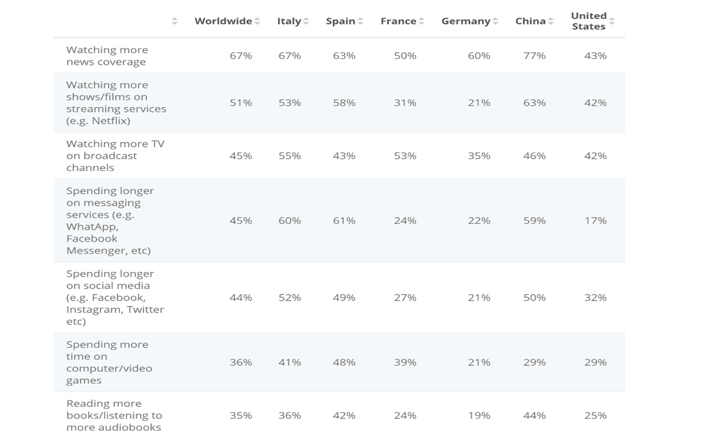The coronavirus pandemic has had an enormous impact on the entire world in the past few months. Not only is it affecting businesses, but also the daily routines of people all around the world. As everyone is stuck at home, people are changing their habits. Since the global pandemic has started, there has been a massive surge in internet usage. This surge in internet usage can be attributed to the increased amount of media consumption worldwide. Data shows that there has been a 61% increase in social media engagement (Digital Information World). Web browsing has seen a 70% growth (Digital Information World). Even traditional media such as TV has also increased by 63 % (Digital Information World). Of all the social media applications, WhatsApp has seen the highest growth.

Increase in Media Consumption at Home
A survey was conducted in March 2020, which stated that COVID-19 primarily had a direct impact on global consumption of in-home media. Owing to the consumption habits of consumers evolving, there has been a massive increase in overall media consumption. Of the total respondents, 35% (Statista) started to read more books or listening to audiobooks. Even the consumption of traditional forms of media such as radio increased by 18%(Statista). During the global pandemic, more than 40% (Statista) of people spent more time on social media and messaging platforms. Over 50% (Statista) of respondents from all countries surveyed also stated that more time was being spent on watching news coverage.
In-home media consumption increase

Source: Statista.com
However, the figures for Australia and the United States were lower than the rest of the world. In these countries, the percentage of respondents who watched more news was 42% and 43% (Statista), respectively. The survey also found that people in Australia were the least likely to be reading newspapers. While 14% (Statista) of the global population read newspapers, only 5% of Australians did so. In Italy, one of the worst-hit countries by the pandemic, 60% (Statista) of people were spending more time on messaging services. While in Japan, only 8% (Statista) of respondents spent more time on social media. Responders from China and the Philippines mostly kept themselves entertained with music streaming services.
Impact of the Pandemic on the Usage of Social Media Platforms
The COVID-19 global pandemic has had a massive impact on the daily routines of people all around the world. As a result, the usage of various social media platforms has also increased. Let us look at how it has affected them and how they are responding to it.
WhatsApp – Kantar surveyed around 25,000 participants from 30 markets to check the popularity of the messaging service after the virus outbreak from March 14 to March 24. It was observed that the usage of the platform grew as the severity of the virus increased. In the initial stage of the virus, the usage of the messaging service grew by 27% (Digital Information World). In the middle phase of the virus outbreak, the usage of the app reached 41% (Digital Information World). In several countries where the virus is in its later stages, the use of WhatsApp has increased by over 51% (Digital Information World). In some markets, such as Spain, the time spent on the app increased by over 76% (Digital Information World). As people across the globe self-isolate themselves, individuals have been extensively indulging in video calling to bridge the gap of loneliness and stay connected to their friends and loved ones.
Facebook – The most prominent social media site in the world has seen an extreme spike in global usage due to the coronavirus pandemic. However, private messaging and video calling are the two segments which have witnessed an upsurge in usage. These are services that Facebook does not monetize. As a result, its business is suffering, and it is struggling to maintain its communication tools up and running. Even digital ad spending on Facebook and Instagram is decreasing. The increased traffic is not translating into profits for the company. Like other businesses, even Facebook has been adversely affected by the pandemic.
Twitter – The social media platform is gaining recognition for aiding in disaster or crisis management processes. World leaders such as Donald Trump, Justin Trudeau, Narendra Modi are using Twitter to spread awareness about COVID-19 as press conferences can’t be held frequently for propagating minor coronavirus updates but can be compiled in a 140 words tweet. While the usage of the platform has seen an up surge of 23% (Reuters) 164 million quarter-to-date, Ned Segal – Twitter’s CFO said that the global advertising revenue has been impacted due to coronavirus.

Source: Twitter.com
Consumer’s Perception of the Reliability of News Sources During the Pandemic

Source: Brandwatch.com
As the virus is moving into its later stages in several parts of the world, audiences are spending more time watching the news coverage. However, with the exponential increase in the spread of misinformation, the reliability of many news sources if being questioned. A survey conducted by Pew Research Center, divided participants by the source they use to consume news. The study found that only 37% (Digital Information World) of social media users expected a vaccine to be made available in a year. According to current scientific claims, the information about a vaccine is correct. Over 50% (Digital Information World) of consumers of traditional media answered this question correctly. About 57% (Digital Information World) of people who agreed to be dependent on social media for news said that they had read made up news on various social media platforms. The statistic was around 37% (Digital Information World) for consumers of print media. Most consumers feel that social media news exaggerates the risks of the virus more than traditional print media.

Source: Gurufocus.com
The Effect of COVID-19 on Consumer Behavior
Since the entire world is confined to their homes, business and consumer habits are undergoing a significant change. IZEA conducted a survey of internet users in the US to predict how a lockdown might change consumer behavior. The study found that 99% (Talking Influence) of the respondents think they will make online purchases if they are stuck at home. However, most online shopping would include grocery items. Companies such as Amazon and Walmart are expecting a sharp rise in online orders. The CEO of IZEA also thinks that the current scenario is an opportunity for marketers to connect with an audience that is captive and looking for services.
With the enormous increase in social media usage, competition amongst brands will also increase. Therefore, it is crucial for brands to communicate with their audience authentically and sensitively. This will allow them to increase their brand’s value to the consumers. Thus, brands might start spending more money on influencer marketing dueto the changing environment. It is essential for them to adjust the campaign spending in order to be aligned with the increased social media consumption.

